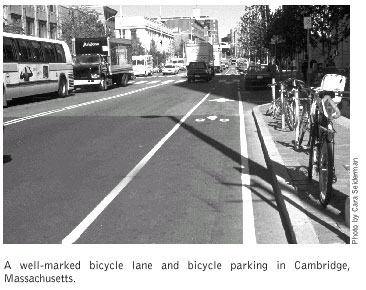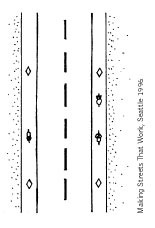10. Adding Bicycle Lanes
Bike lanes indicate a preferential or exclusive space for bicycle travel along an arterial street. Bike lanes have been found to cause more consistent separation between bicyclists and passing motorists and have been shown to increase safety for cyclists. Marking bicycle lanes can also benefit pedestrians - as turning motorists slow and yield more to cyclists, they will by default also be doing so for pedestrians.
Bike lanes are typically designated by striping
and/or signing, although colored pavement (e.g., blue or red bike lanes)
has also been used in certain situations. As striping bike lanes reduces
the space dedicated to motor vehicles, safety may be enhanced for pedestrians
who wish to cross the street. Bicycle lanes also provide a buffer between
motor vehicle traffic and pedestrians when sidewalks are immediately adjacent
to the curb.


Purpose:
- Create on-street travel facilities for cyclists.
- Narrowing the roadway may reduce motor vehicle speeds.
- Provide additional separation between pedestrians and motor vehicles.
- Adding on-street lanes reduces the effective crossing distance for pedestrians.
Considerations:
- All roads should be evaluated for adequate bicycle facilities
Estimated cost
The cost of installing a bike lane is approximately $5,000 to $50,000 per mile, depending on the condition of the pavement, the extent of removing and repainting of lane lines, the need to adjust signalization, and other factors. The best time to create bicycle lanes is during regular street reconstruction, street resurfacing or at the time of original construction.